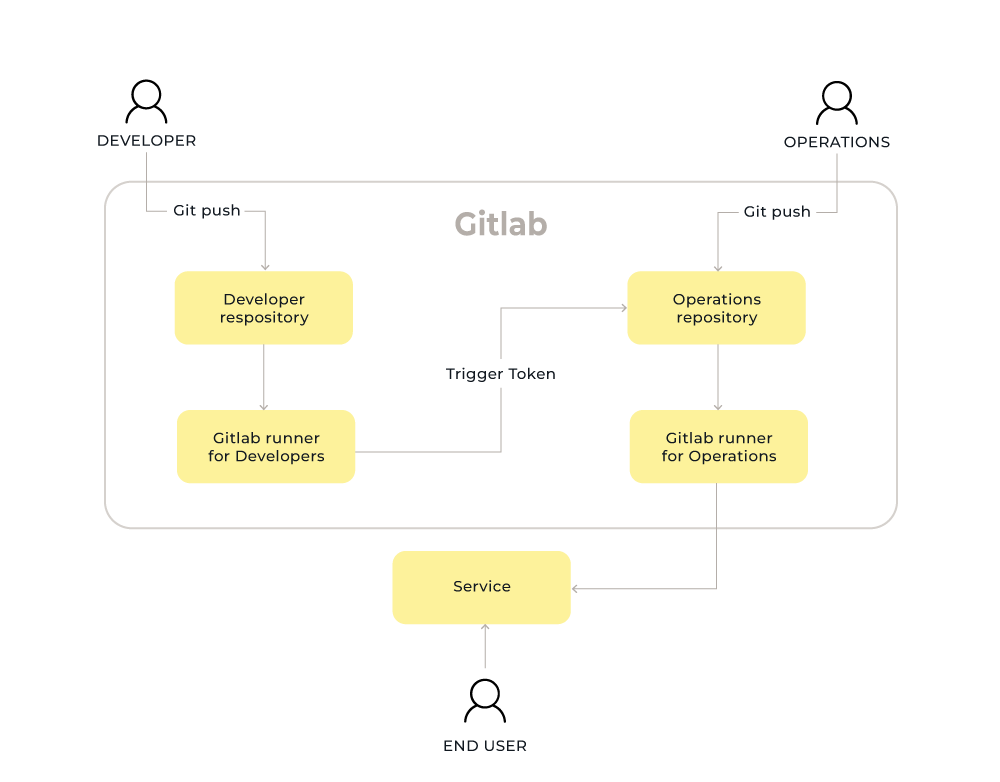Separation of duties in DevOps and GitLab: Overcoming the 4 main challenges

In the world of DevOps, where speed and flexibility are critical, it can be difficult to establish separation between different tasks—”separation of duties”.
You need separation of duties for security and responsibility reasons. For example, it is critical in a situation such as developing and testing financial systems.
In this case:
- Developers focus on writing and checking code
- Testers independently test to make sure the calculations in the system are correct and meet regulatory rules
But it can be difficult to implement in the context of DevOps and GitLab.
In this blog, we'll explore the challenges you may face when trying to enforce separation of duties, and how to overcome them effectively.
Read on and be better at balancing security with efficiency. Let’s start with the challenges and how to overcome them.
The 4 key challenges of separation of duties in DevOps and GitLab—and how to overcome them
Challenge 1: Limited built-in controls
GitLab—a collaboration platform—doesn't have built-in tools for enforcing the separation of duties. It's designed to be flexible and open, which is good, but it also means you need to put in extra work and make some changes to have the right controls in place. Organizations might find it difficult to limit certain actions or restrict access to certain things based on specific job responsibilities.
Overcome this challenge through customization and configuration
You can make the most of GitLab's customization options to set up access controls, permissions, and workflows based on different roles. By adjusting GitLab's settings, you can make sure each person only has access to the things they need for their specific job.
This way, you can align GitLab with your organization's requirements for keeping tasks separate and ensure that everyone has the right level of access to the resources they need.
Challenge 2: Overhead and complexity
Introducing separation of duties in a DevOps environment can bring extra challenges with overhead and complexity. You need to define roles, manage access controls, and set up review processes, which can take up time and resources.
To find the right balance between security and efficiency, you need careful planning and coordination to make sure everything works smoothly.
Overcome this challenge with an integrated toolchain
Consider using a GitLab toolchain for your entire pipeline, including access management, code reviews, and automated testing. GitLab can assist in enforcing the separation of duties by allowing controlled access, making it easier to review code together, and automating security checks.
Challenge 3: Collaborative bottlenecks
Sometimes, when you try to enforce separation of duties, it can slow down the development process. Having multiple people or teams review and approve changes can cause bottlenecks and make it take longer to deliver software.
It's important to find a balance between collaboration and the need for independent checks to make sure everything is secure. You want to maintain agility while still meeting security standards.
Overcome this challenge through education and awareness
Make sure everyone on the team understands why separation of duties is important for security and compliance. Hold training sessions and encourage a culture where everyone takes responsibility for their part, emphasizing the advantages of independent checks and validation.
Challenge 4: Tooling and automation
To achieve a successful separation of duties, you typically need to use the right tools and automation. But it can be difficult to find or create solutions that work well with the DevOps workflow and seamlessly integrate with GitLab. So you need to invest enough time and resources in identifying or building tools that enable secure and efficient collaboration while still supporting the separation of duties.
Overcome this challenge through continuous improvement
Make it a habit to regularly evaluate how well your controls and processes for the separation of duties are working. Seek feedback from team members and stakeholders to pinpoint areas that can be enhanced, and fine-tune the implementation as time goes on.
Aim for a balance between security needs and operational efficiency, making any necessary adjustments along the way.
Now let’s have a look at an example.
A typical GitLab trigger token workflow for developers and operations

To illustrate how separation of duties can be implemented in a DevOps environment using GitLab, let's consider an example involving a trigger token workflow.
In this scenario, developers work in one repository, while operations teams handle deployments and infrastructure management in another one.
1. Developer repository
Developers focus on writing code, creating new features, and ensuring code quality. They work within a dedicated repository where they collaborate, review each other's code, and perform unit testing. Once the code is ready, developers push their changes to the main branch of the developer repository.
2. Trigger token
To start the deployment process and maintain the separation of duties, a trigger token mechanism is used. This mechanism involves setting up a pipeline in the developer's repository. Once the code has been reviewed and tested successfully, it generates a trigger token that initiates the deployment.
3. Operations repository
The trigger token activates a pipeline in the operations repository, signaling the handover to the operations team. This repository holds deployment scripts, infrastructure configurations, and other essential operational tasks needed for deploying and maintaining the application.
4. Deployment and infrastructure management
Using the trigger token, the pipeline in the operations repository starts the deployment process. The operations team takes charge of responsibilities like provisioning infrastructure, deploying the application to staging or production environments, and overseeing other operational aspects of the system.
5. Auditing and oversight
During the workflow, GitLab allows for auditing and oversight. It keeps a record of the actions carried out by developers and operations teams, ensuring traceability and accountability. This feature helps meet compliance requirements and enables efficient investigation of any issues or abnormalities.
Why this trigger token workflow is great
You separate duties
The trigger token workflow ensures that developers, who are responsible for code changes, do not have direct access to deployment and infrastructure management. With this separation, you prevent unauthorized changes, reduce the risk of errors, and enhance security.
You achieve collaboration and efficiency
By dividing responsibilities between developers and operations teams, with this workflow, each team can collaborate internally in a more focused way. Developers can concentrate on writing code and improving application features, while operations teams can focus on maintaining a stable and secure infrastructure.
You are compliant and ready for auditing
By implementing the separation of duties through the trigger token workflow, you will meet regulatory requirements. And with GitLab's audit trail and oversight features, you can show that you are accountable and fulfill your compliance obligations.
This GitLab trigger token example illustrates how you can establish separation of duties in a DevOps environment.
A drawback of this model, though, is that developers don’t have control over the deployment process and may not have visibility into when and by whom a deployment was performed.
In summary
Implementing separation of duties in the context of DevOps and GitLab presents its own set of challenges. You are battling the limitations of default controls and the complexity involved, and you need to strike a balance between collaboration and security.
But you can overcome all these challenges by using customization options, using integrated tools, providing education, and prioritizing continuous improvement.
This way, you can establish a strong framework for the separation of duties. You can ensure security, accountability, and compliance with regulations, and at the same time enjoy the awesome collaborative benefits you get with DevOps and GitLab.
Published:
Updated:



